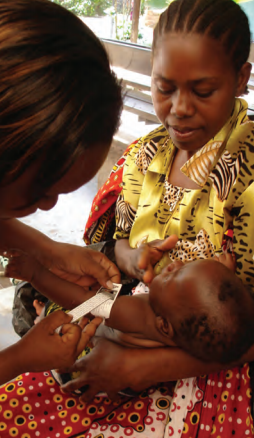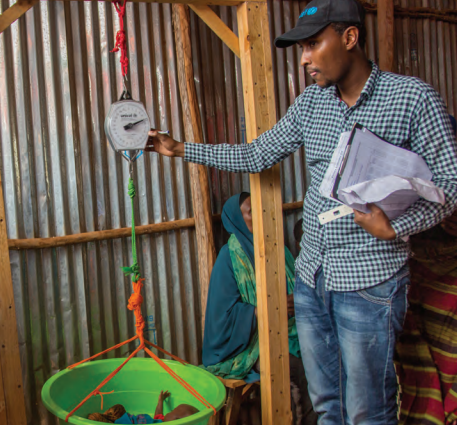Methods to detect cases of severely malnourished infants under six months
Summary of research1
Location: Global
What we know: The World Health Organization (WHO) recommends weight-for-length z score (WLZ) as an anthropometric indicator to identify severe acute malnutrition (SAM) in infants <6m.
What this article adds: A review was undertaken of recent evidence of methods for detecting acute malnutrition in infants <6m to assess their ability to reflect both mortality risk and nutritional status in this age group. Clinical and anthropometric methods were assessed against 11 criteria (simplicity; acceptability; cost; precision; accuracy; sensitivity; specificity; predictive value; objectivity; quantitativeness; and independence of age). Weight-for-age (WFA), mid-upper-arm circumference (MUAC) and MUAC-for-age (MUAC/A) were rated the best indicators of acute malnutrition and associated mortality in this age group, based on current evidence. MUAC/A compared to MUAC with a single cut-off (<11cm) does not add to sensitivity, specificity or predictive value. WFA may be useful in certain community settings where weight measurements are taken routinely. WFL scored poorly in terms of simplicity, acceptability, cost, accuracy and poorer predictive value for mortality; difficulties in accurately measuring length in the age group are also an important constraint. The review proposes MUAC and WFA alongside simple clinical indicators should be used to identify acute malnutrition in infants <6m, including infants born small or pre-term. Priorities for future research include a formal evaluation of the community management of uncomplicated acute malnutrition in infants < 6 months of age (C-MAMI) tool and assessment of MUAC and WFA at scale in the community in this age group.
 World Health Organisation (WHO) guidelines currently recommend using weight-for-length z-scores (WLZ) to diagnose severe acute malnutrition (SAM) in infants less than six months old (infants <6m). However, this recommendation is based largely on convention of diagnosis in older children rather than scientific evidence. Guided by an existing review of children aged 6-59 months (Myatt et al, 2006), this paper examines recent evidence to evaluate possible methods for detecting acute malnutrition in infants <6m in community and healthcare settings. The review assessed clinical and anthropometric ability to reflect both mortality risk and nutritional status in this age group. Methods were scored against 11 criteria: simplicity; acceptability; cost; precision; accuracy; sensitivity; specificity; predictive value; objectivity; quantitativeness; and independence of age. Indicators were identified from a 2012 systematic literature review for admission and discharge criteria for this age group (Kerac et al, 2012) and papers published since 2012 or in press, found in a search of PUBMED and through personal communications with authors.
World Health Organisation (WHO) guidelines currently recommend using weight-for-length z-scores (WLZ) to diagnose severe acute malnutrition (SAM) in infants less than six months old (infants <6m). However, this recommendation is based largely on convention of diagnosis in older children rather than scientific evidence. Guided by an existing review of children aged 6-59 months (Myatt et al, 2006), this paper examines recent evidence to evaluate possible methods for detecting acute malnutrition in infants <6m in community and healthcare settings. The review assessed clinical and anthropometric ability to reflect both mortality risk and nutritional status in this age group. Methods were scored against 11 criteria: simplicity; acceptability; cost; precision; accuracy; sensitivity; specificity; predictive value; objectivity; quantitativeness; and independence of age. Indicators were identified from a 2012 systematic literature review for admission and discharge criteria for this age group (Kerac et al, 2012) and papers published since 2012 or in press, found in a search of PUBMED and through personal communications with authors.
Results
The literature highlighted the following indicators for infants <6m: weight-for-length (WFL); weight-for-age (WFA); length-for-age (LFA), mid-upper arm circumference (MUAC), MUAC-for-age (MUAC/A) and clinical indicators, such as the infant being too weak to suckle effectively and breastfeeding issues (or ‘maternal milk insufficiency’ (MMI)). Findings against each of the 11 criteria were as follows:
Simplicity
Clinical assessment methods vary in their simplicity; assessment of infant suckling takes patience and training, whereas MMI relies on mother’s reporting. A new tool, community management of uncomplicated acute malnutrition in infants < 6 months of age (C-MAMI), provides a simple form of clinical assessment, preferred by basic health staff. Assessment of age in infants <6m appears to be more reliable than that for older children; however formal evaluation of this is needed. Pre-term or low birth weight infants are more likely to be identified as malnourished, which may lead to unnecessary intervention; however elevated risk of mortality in this age group means they should be equally included in nutrition interventions (Mwangome et al, 2017).
Mothers and health workers can find the process of measuring length in the <6m age group difficult, whereas weight measurements are routine, more acceptable and scales are more likely to be available. Calculating z-scores or using look-up tables is complex for healthcare staff, particularly for WFL, which requires use of different length and height tables. MUAC may be a simpler indicator as no z-scores are required and minimal equipment and training are needed.
Acceptability
 The presence of a male health worker and/or insufficient privacy reduce the acceptability of breastfeeding assessment tools to carers; assessments that rely on questions alone rather than observations may be more acceptable. Carers and infants can become distressed during both length and weight measurements and the handling of heavy, bulky length boards reduces the acceptability of length assessments for health workers. MUAC for infants <6m may be more acceptable to carers and operators as the infant can remain dressed, stay in their carer’s arms, the mother can take the measurement and MUAC tapes are highly portable.
The presence of a male health worker and/or insufficient privacy reduce the acceptability of breastfeeding assessment tools to carers; assessments that rely on questions alone rather than observations may be more acceptable. Carers and infants can become distressed during both length and weight measurements and the handling of heavy, bulky length boards reduces the acceptability of length assessments for health workers. MUAC for infants <6m may be more acceptable to carers and operators as the infant can remain dressed, stay in their carer’s arms, the mother can take the measurement and MUAC tapes are highly portable.
Cost
Some breastfeeding assessment tools are costly in terms of personnel, equipment and time, although other, simpler tools require less training, including the clinical assessment section of the C-MAMI tool. Hanging spring scales cost less than other scales and are routinely used in community programmes; length boards may prove too costly for some programmes. MUAC is likely to be the least costly assessment method as the equipment required is cheap (£0.30) and minimum training is required.
Objectivity and quantitativeness
Clinical assessment is generally considered to be subjective and difficult to standardise and express quantitatively, whereas anthropometric indicators are generally regarded as objective and quantitative. Simple, low-cost and objective methods may be most useful for community frontline screening.
Independence of age
Earlier studies found MUAC to be relatively independent of age in older children but less so in infants under one year old. However, a recent study in Kenya found that a single MUAC threshold of <11cm performed similarly to MUAC/A in predicting mortality in infants <6m (Mwangome et al, 2017). The same study also found that WFL, WFA and LFA were associated with age in infants <6m.
Precision and accuracy
Both accuracy and precision of age have been highlighted as questionable among older children but have not been assessed in infants <6m. Weight using hanging scales with 100g graduation units may not be accurate enough for this age group, although this needs formal assessment. Studies show that accuracy of weight can be greatly influenced by clothing. Health workers appear to make fewer mistakes using MUAC compared to WFA and WFH for older children and may under-diagnose infant malnutrition when using WFL. Reliability of z-score calculations and infant anthropometry data can be low, with more missing data values and errors compared to older children.
Sensitivity, specificity and predictive value
Evidence suggests that existing breastfeeding assessment tools would be neither sensitive enough for outpatient care nor specific enough for inpatient care. Further studies are needed to identify standardised breastfeeding indicators which correctly capture mother’s concerns, as these are likely to be sensitive and predictive. One study in Kenya found that a MUAC cut-off of <11cm identified 24% of hospitalised infants at risk of inpatient mortality with a sensitivity of 70% and specificity of 68%, compared to WFA <-3 z-score, which was less sensitive (55%) but more specific (80%). In terms of predictive value, MUAC and WFA were found to be better at predicting mortality compared to WFL and LFA in an inpatient setting (Mwangome et al, 2017). Other studies support the greater predictive value of WFA compared to WFL and LFA. Another study in Kenya showed no significant difference in predictive value when using a combination of MUAC and/or WFA compared to MUAC alone, although WFA identified additional infants with high case fatality (Mwangome et al, 2017a).
Despite relatively low prevalence, checking for kwashiorkor should be included as an additional indicator of SAM in infants <6m as checking is simple, acceptable, low cost, largely objective and independent of age.
Conclusions
Based on current evidence, the best indicators of acute malnutrition and associated mortality in infants <6m appear to be WFA, MUAC and MUAC/A. A fixed MUAC cut-off rate has the additional benefit of not depending on age, which can add inaccuracy. WFA suffers from the potential imprecision of cost-effective scales; however overlap of weight measurements with other routine health checks makes WFA feasible in many settings. WFL, although the current recommended indicator, scored poorly in this review, largely due to inaccuracy, difficulties associated with measuring length and poorer predictive value for mortality. The authors recommend MUAC and WFA, alongside simple clinical indicators and identification of kwashiorkor, as standard indicators for acute malnutrition in infants <6m, including infants born small or pre-term.
Priorities for future research include a formal evaluation of the C-MAMI tool and an assessment of the use of WFA and MUAC at scale in the community for infants <6m, taking into account use of different weighing scales and accuracy of age calculations.
Footnotes
1Lelijveld N, Kerac M, McGrath M, Mwangome M, Berkley J. (2017) A review of methods to detect cases of severely malnourished infants less than 6 months for their admission into therapeutic care.
2http://www.ennonline.net/c-mami
References
Kerac M, Trehan I, Weisz A, Agapova S, Manary M. Admission and discharge criteria for the management of severe acute malnutrition in infants aged under 6 months. Geneva: World Health Organization 2012.
Mwangome MK, Ngari M, Fegan G, et al. (2017) Diagnosis Criteria For Severe Acute Malnutrition Amongst Infants Aged Under 6 Months. The American Journal of Clinical Nutrition 2017.
Mwangome MK, Ngari M, Fegan G, et al. (2017a) Diagnosis Criteria For Severe Acute Malnutrition Amongst Infants Aged Under 6 Months. Personal communication with authors 2017.
Myatt M, Khara T, Collins S. A review of methods to detect cases of severely malnourished children in the community for their admission into community-based therapeutic care programs. Food and nutrition bulletin 2006;27:S7-S23.


